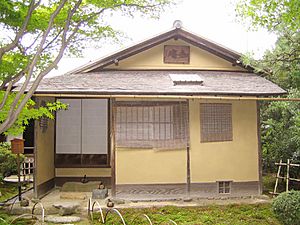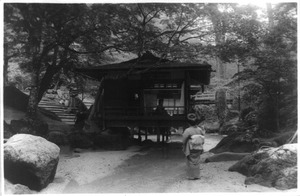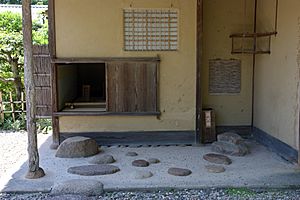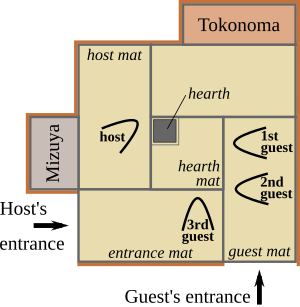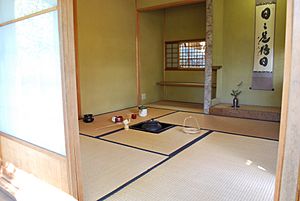Chashitsu facts for kids
A Chashitsu (茶室, meaning "tea room") is a special building or room in Japan. It is made just for the tea ceremony, called chanoyu. This is a peaceful gathering where people enjoy tea together.
The way chashitsu are built is called the sukiya style (sukiya-zukuri). Sometimes, sukiya is even used to mean chashitsu. Other related Japanese words are chaseki (茶席), which means "a place for tea," and chabana, which are the special flower arrangements used in tea ceremonies.
Chashitsu usually have shōji windows and sliding doors. These are made of wood frames covered with thin, see-through Japanese paper. The floors are covered with tatami mats. There is also a special alcove called a tokonoma. The colors and style are simple and calm. Most chashitsu are about 4.5 tatami mats big.
Contents
What is a Chashitsu?
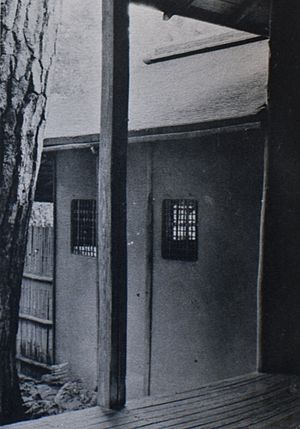
In Japan, both separate buildings and single rooms made for tea ceremonies are called chashitsu. The word can mean just the room where guests drink tea. It can also include the whole building and even the roji garden path leading to it. In English, we often call separate buildings "tea houses" and rooms inside other buildings "tea rooms."
Tea Houses
Tea houses are usually small, simple wooden buildings. You can find them in gardens of homes, temples, museums, or parks. The smallest tea house has two rooms. One is the main room where the host and guests gather for tea. The other is a mizuya, where the host gets sweets and equipment ready. The whole building might be as small as three tatami mats.
Larger tea houses can have many tea rooms of different sizes. They might have a big mizuya (like a modern kitchen) and a large waiting room for guests. There could also be a welcome area to take off shoes, separate bathrooms, and a storage room. Sometimes, they have extra rooms and a garden with a roji path.
Tea Rooms
Tea rooms are spaces built just for tea gatherings. They can be inside bigger tea houses or within regular homes. A tea room can be as small as 1.75 tatami mats. This includes one full mat for guests and a smaller mat called a daime (台目) for the host to prepare tea. They can also be as large as 10 tatami mats or more. A size of 4.5 mats is often thought to be perfect for modern tea rooms. A tea room usually has a tokonoma and a sunken hearth for making tea in winter.
History of Tea Houses
The word chashitsu became common after the Edo period (around 1600). Before that, people used different names for tea spaces. For example, they said chanoyu zashiki ("sitting room for tea") or sukiya (a place for artistic hobbies like tea). Some say that Ashikaga Yoshimasa, a shogun, built the first chashitsu. It was a small room of 4.5 tatami mats, separate from his main house in Kyoto.
The idea of wabi-style tea ceremony started in cities during the Muromachi period (1336 to 1573). It grew from tea houses that city people built. Before this, tea ceremonies were often held in rooms built in the shoin-zukuri style. This style is still used in many tea rooms today.
Tea houses first appeared during the Sengoku period (mid-1400s to early 1600s). This was a time of much fighting and change in Japan. Samurai and merchants who practiced tea ceremony built these houses. They wanted simplicity and peace, which are key ideas in Zen Buddhism. This focus on simple, plain design became a lasting Japanese tradition.

The Golden Tea Room (黄金の茶室, Ōgon no chashitsu) was a special, portable tea house. It was covered in gold and built in the 1500s for Lord Toyotomi Hideyoshi. He was a powerful Japanese leader. The original room is gone, but new versions have been made. This golden room was meant to show off Hideyoshi's power. This was different from the simple style taught by his tea master, Sen no Rikyū. Even so, the room's simple lines could still be seen as part of the tea ceremony style.
How Chashitsu are Built
An ideal free-standing tea house has a small Japanese garden around it. A path in this garden leads to the tea room. This path is called roji (露地, "dewy ground"). It is split into two parts by a gate. Along the path, there is a bench for guests to wait.
Near the tea house, there is a stone basin with water. Guests wash their hands and mouths here before going into the tea room. They enter through a low, square door called nijiriguchi. This "crawling-in entrance" makes you bend low to get through. It helps you feel like you are leaving the busy outside world and entering a calm, simple space. The nijiriguchi leads right into the tea room.
The tea room has a low ceiling and no furniture. Guests and the host sit on the floor in seiza style. All the materials used are simple and natural. Besides the guests' entrance, there is at least one more door for the host. This door, called the sadōguchi, leads to the mizuya (preparation room). Windows are usually small and covered with shōji paper. This lets natural light come in softly. The windows are not meant for looking outside, so people can focus on the tea ceremony.
In colder months, there is a sunken hearth (炉 ro) in the floor for preparing tea. This hearth is covered and hidden in warmer months. Then, a portable brazier (風炉 furo) is used instead.
There is a tokonoma (scroll alcove) in the room. It holds a scroll with calligraphy or a painting. Sometimes, there is also a simple flower arrangement called chabana. There are no other decorations.
Chashitsu are often grouped by their size. Those larger than 4.5 tatami mats are called hiroma ("big room"). Those smaller are called koma ("small room"). The size affects how the ceremony is done, what equipment is used, and how many guests can fit. Hiroma rooms are often in the shoin style and can be used for more than just tea ceremonies.
Other things that affect a tea room's design include where the windows, doors, hearth, and tokonoma are placed. This is especially true if the tea room is not in a building made just for tea.
Common Names for Chashitsu
Chashitsu are often given special names by their owners. These names usually include words like "hut," "hall," or "arbor." They show the simple, natural spirit of the tea ceremony and Zen Buddhism. Some examples are:
- Mugai-an (無外庵, Introvert Hut)
- Mokurai-an (黙雷庵, Silent Thunder Hut)
- Tōkyū-dō (東求堂, East-Seeking Hall)
- Shō-an (松庵, Pine Hut)
- Ichimoku-an (一木庵, One Tree Hut)
- Rokusō-an (六窓庵, Six Window Hut)
- Bōji-tei (忘路亭, Forgotten Path Arbour)
Famous Chashitsu
- Tai-an (待庵): Built in 1582, this is the only tea house still existing that was designed by Sen no Rikyū. It shows his idea of wabi-cha (simple tea). It is in Myōki-an temple in Yamazaki, Kyoto. It is a National Treasure.
- Jo-an (如庵): Built in Kyoto in 1618 by Urakusai, the younger brother of Oda Nobunaga. It was moved to Inuyama in Aichi in 1972. It became a National Treasure in 1951.
- Konnichi-an (今日庵, Today Hut): Built by Sen no Sōtan. It has a very small floor space. There is no recessed tokonoma.
- Fushin-an (不審庵, Doubting Hut): Designed by Sen no Rikyū. His son moved it to the Omotesenke estate.
- Zangetsu-tei (残月亭, Morning Moon Arbour): This tea house belongs to the Omotesenke school in Kyoto.
- San-meiseki (三名席, Three Famous Tearooms):
- Sarumen Chaseki (猿面, Monkey face tea place) at Nagoya Castle. It was destroyed in 1945 but rebuilt in 1949.
- Yatsu-mado no seki (八窓の席, Eight Windows) or Hasō-an (八窓庵) at Isshin-ji in Osaka. It was designed by Lord Kobori Enshū.
- Rokusō-an (六窓庵, Six Window Hut) from Kōfuku-ji in Nara. It is now in the gardens of the Tokyo National Museum.
- Shōkin-tei (松琴亭) at Katsura Imperial Villa in Kyoto.
- Golden Tea Room: Built for the leader Toyotomi Hideyoshi.
- Glass Tea House - KOU-AN (光庵, Light Hut): Designed by Tokujin Yoshioka.
- Ki-an: A tea house made of bamboo.
Images for kids
-
Yugao-tei in Kanazawa, Ishikawa
See also
 In Spanish: Chashitsu para niños
In Spanish: Chashitsu para niños


